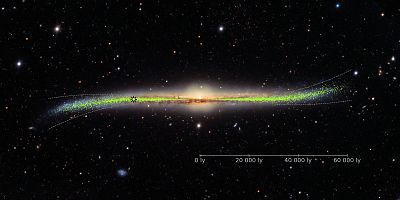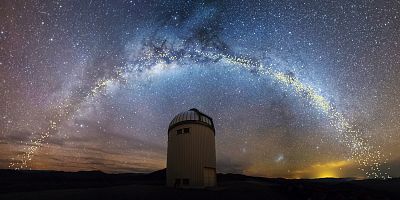New research shows our home galaxy is warped and twisted.
It's bent — big time.
A new study of the Milky Way shows that our home galaxy is significantly warped. Instead of forming a relatively flat disk, the hundreds of billions of stars that make up the Milky Way form a disk that's noticeably twisted at the edges, a bit like a flattened letter "S."
"I'd say that it is shaped like a Pringle," said study co-author Radek Poleski, an astronomer at Ohio State University in Columbus.
For decades, astronomers assumed that the Milky Way was relatively flat, like most other spiral galaxies (the Milky Way is a so-called barred spiral galaxy, a whirlpool of stars and interstellar clouds with a bright bar across the middle). The new research, which was published Aug. 2 in the journal Science, confirms recent research showing that the galaxy is warped but also shows that the distortion is more pronounced than astronomers had suspected.
The Milky Way is estimated to have a diameter of just over 100,000 light-years, and our solar system is embedded within it about 25,000 light-years from the galaxy's center. So it's hard to see the bend from our vantage point — and vast clouds of interstellar gas and dust within the galaxy make the task even harder, Poleski said.
But Poleski and astronomers at the University of Warsaw in Poland created a new super-detailed map of the Milky Way using so-called variable stars known as classical Cepheids, which brighten and dim over a period of days at a rate corresponding to their size. At their brightest, classical Cepheids can be 10,000 brighter than our sun, so they're visible across vast distances and through the clouds of gas and dust.
Space
Using observational data from the Optical Gravitational Lens Experiment (OGLE), an ongoing survey of stars in the southern sky made using a specialized telescope in Chile's Atacama Desert, the astronomers determined accurate positions for more than 2,400 classical Cepheid stars by comparing the light they were known to produce with the light from them seen here on Earth.
"When we measure the period of a star, we know how much absolute light it emits," Poleski said. "Then we can compare it with the light that we are getting, and by comparing those two we get the distance."
What explains our galaxy's weird shape? Richard de Grijs, an astronomer at MacQuarrie University in Sydney, Australia, attributed it to the effects of gravitational interactions with neighboring galaxies.
It's also possible that our galaxy twisted as it merged with smaller galaxies in the distant past, he said, or that its warped shape is the result of the combined gravity of the spiral arms themselves, which could pull stars and clouds at the edges away from the flat plane of the rest of the galaxy.
De Grijs, who was part of a team who measured the galaxy's bend in research published earlier this year, said the new study confirmed and expanded upon the earlier research. "They found pretty much the same result, which is comforting," he told NBC News MACH in an email.
The researchers plan to refine their model of the galaxy with help from telescopes that can see stars in the northern sky.













